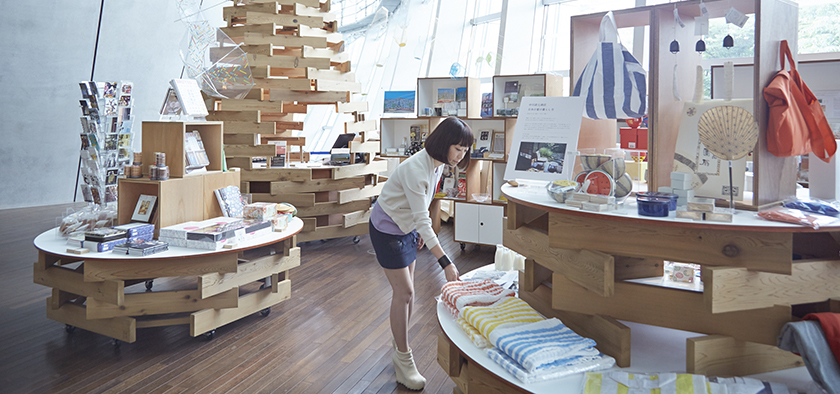
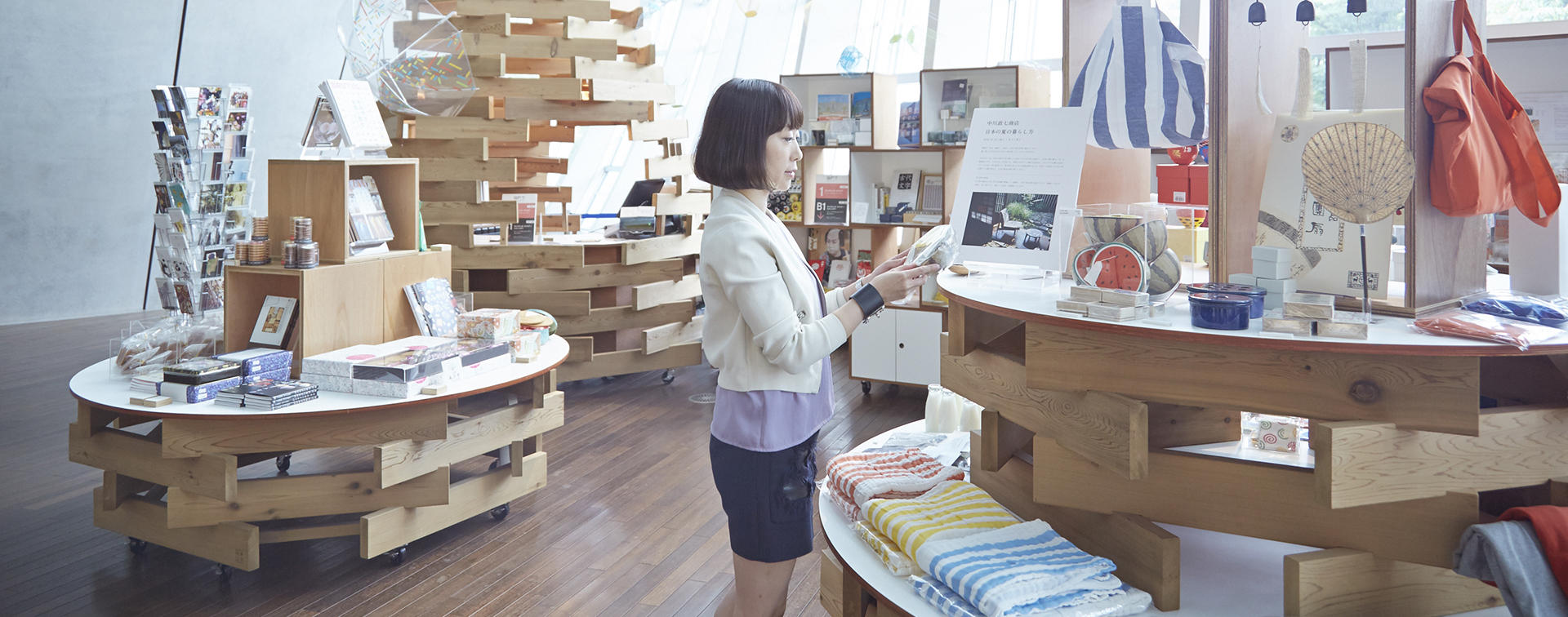
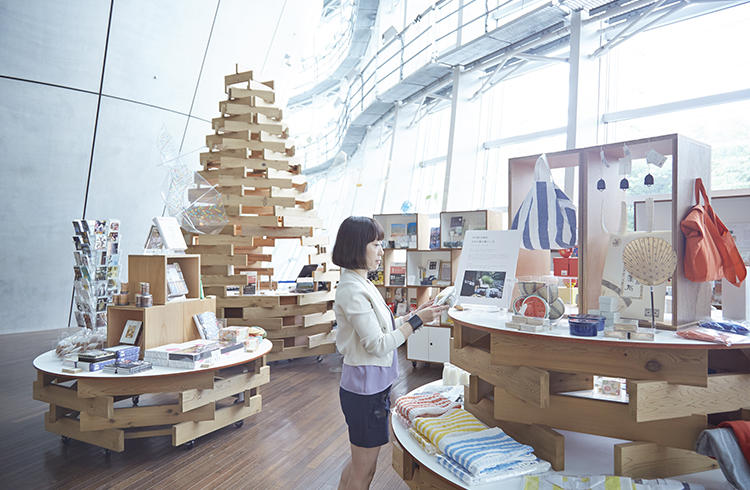
Art and advertisements - creating works to make people happy
Turning the whole Roppongi into a work of art
Rika Eguchi works in many genres: as an art director at an advertising agency she has been involved in numerous commercial campaigns, while as an artist, she has exhibited art installations at home and abroad, created an original series of tableware from her glass artworks, and designed costumes for figure skater Daisuke Takahashi. We asked Eguchi about her ideas on making Roppongi into an interesting place.
My husband proposed to me in Roppongi
Roppongi is a place that has been good to me, both personally and professionally. In 2009 when I received the JAGDA New Designer Award, I participated in an exhibition in Roppongi, and then I was invited to be juror for the JAGDA awards. When I was a student, a museum shop in Roppongi Hills agreed to sell the "Barnbrook's Eggs" that I made. As soon as it opened, the "Souvenir from Tokyo" shop at the National Art Center, Tokyo started selling the items too - although I've stopped making them for the time being.

JAGDA Award
An award launched in 2008 by the Japan Graphic Designers Association (JAGDA) to award and record works of excellent graphic design. Works by the award winners of 2016 are currently being shown at the "Graphic Design in Japan 2016" exhibition at Tokyo Midtown's Design Hub. (The exhibition will be on until Aug. 8)
On a personal level, my 30th birthday party was held in Roppongi and it was also here that my husband proposed to me. I no longer feel that way, but when I was younger and single, I felt that all the memorable events had to take place in Roppongi. (laughs)
After getting married, we often come as a family to Mori Art Museum and we also watch movies at Toho Cinemas Roppongi. For me, Roppongi is an area to enjoy something a little different from the usual daily routine. These days, Roppongi seems to have become posh and conservative and though there is nothing wrong with that, I wish the place would become a little more adventurous. (laughs) Then I would want to come here more often.
An area where art is visible in every direction you look at
If Roppongi is to be called an area of design and art, I think art should be prevalent in the whole area and the streets should be as interesting as the artworks. Otherwise, it won't be exciting. Instead of playing safe and doing something that has proved successful elsewhere, I think you should do something daring that breaks the mold.
For example, you could place artworks everywhere so that as soon as people walk out of the station, they see artwork in every direction they look at. It's nice of course, to have public art installed in the streets and to appreciate works in art museums, but you could come up with something really different if the concept was to turn the whole area into a work of art, rather than just a place to showcase artworks. Instead of relying on pieces of artwork, I think art should be expressed in the area as a whole.
You could ask questions like, "What would the sign boards in an art town look like?" or "What kind of advertisements would be appropriate for an art town?" The reason I go to art museums to look at art is because I want to open my mind and see different ways of looking at things. I think art is about presenting totally new values and artists are people who discover new perspectives. So the signboards and advertisements in an art town should not be of the kind you've seen somewhere before; they should be riveting.
If it becomes an impactful place where it is obvious from the moment you walk into it that it is in area developed in an extraordinary way, I'm sure people will be saying "I have to see Roppongi!"
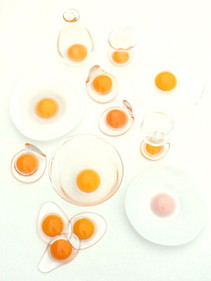
Barnbrook's Eggs
Glass artworks created by Rika Eguchi when she was a student and for which she received awards including the Taro Okamoto Contemporary Art Award (Excellent Award). The works have the realistic appearance of broken eggs and has been turned into various commercial products such as plates, cups and bookstands. (The products are currently not being sold.)
Stretching the boundaries of work
When doing my work, I always try to stretch the boundaries of advertising or design as much as possible. In advertising, the medium is set, and there are many restrictions. Perhaps it would be interesting to make Roppongi into a place that is permissive of all kinds of advertisements.
For instance, you could set up a space exclusively for advertising. The advertising would not be of the usual kind; artists would be in charge of the visuals and instead of advertisements on flat surfaces, monuments could be installed or performances could be staged. The advertising slogans could be thought up by people who are not professional copywriters. A creative director would gather all the different elements and make them into coherent advertisements.
Roppongi could become a place where never-before-seen kind of advertisements are made; if its reputation spreads, people around the world will want to come and see for themselves and there will be passing of information. That would inevitably attract potential clients. Roppongi will come to be recommended as the place to make interesting advertisements.
Not distinguishing between art and design
While working at an advertising agency, I make my own works such as installations and picture books; I don't usually think about whether what I am doing is design or art. I'm satisfied if what I create serves its purpose. When doing advertising, of course I want to sell the product and want people to like it, and I am aware of the things that the client wishes to convey to the customer. In art, I just create things in line with my inner urge, or in line with a certain theme.
The common element in advertising and art is the need to think about how you can convey your thoughts to people. Sometimes, instead of conveying thoughts in a straightforward manner, it can be interesting to convey them in a totally unexpected way. So my challenge is to constantly think about creating expressions that have never been seen before.
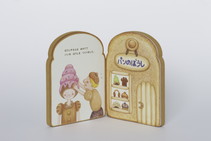
Pan no osama (bread king)
Eguchi's first picture book about a bread king who orders that everything in the land be turned to bread. The covers of the book are made from sponge and resemble bread.

Transforming Roppongi into an outlandish place
Recently, I went to Thailand and visited a night market. All kinds of things were being sold in a very small space; in addition to food and clothes, there were live fish and lots of animals crammed together. The experience was a bit frightening and overwhelming. It was hot and I would have felt unwell if I had stayed there too long, but at the same time, I wished my children could see the place - I wanted to let them know that such a place exists.
Instead of being posh and conservative, it would probably be better for Roppongi to become outlandish - to be very weird but not to the point that it can't be accepted by the public. (laughs) For instance, Roppongi Art Night is like a school festival that is held for a few days each year, but what if that event was held 365 days of the year? Something outrageous like that would make people want to come again - it would attract stimulation-seeking visitors from all over the world.
But to make such a place you have to create something that is unique to Roppongi; there would be no point in offering nice things that are available in other places. And of course you shouldn't make this just a strange, dangerous kind of place. You need to balance the weirdness with everyday life and create a peculiar, yet acceptable place. I suppose you would need the power of both art and design to do that.
Places that make me rethink my values
Recently I went back to my hometown in Obihiro, and I realized what a busy lifestyle I normally lead. When I'm in Tokyo, I take it for granted, and I don't notice how much I'm straining myself. During my stay in Obihiro, my mind became very clear, and I saw that the values of the people living there are very different from the values in Tokyo. I thought, "I've been unconsciously trying to be cool." And the armor that I'd been wearing seemed to come off.
While there are many inconvenient aspects to living in the countryside, the people there are leading proper lives, and there is a lot we can learn from them. Not only are they living well, but their lifestyle is better [than city people] in a way.
When traveling, I like places that make me aware of different perspectives and other ways of thinking - places which make me rethink the values I live by.
New York - a city that prompts people to change
The places I visit are the extremes of both ends - it's either the countryside or the big city. Obihiro is the countryside, and the far opposite of that would be New York. At one time I would be captivated by Chelsea, and after a little while, I would be excited about Brooklyn, and then some time after that, I would be raving about a different area; New York changes so rapidly and there are not many cities like it.
When I go to New York, I enjoy spending my time in the most popular area of the moment, feeling as if I'm in the know. Then after a year, things will have changed. Of course, cities like Paris are interesting, but in Europe, it's as if tradition is at the foundation and new factors are blended into that. In contrast, New York is an experimental place where the newest things are shown, and where uninteresting things quickly vanish. It's a city that doesn't try to adapt itself to people but prompts people to change.
In Japan, once a town has been developed, it keeps offering the same things to the same targeted people. When I go to New York and see the new things there, I feel that Tokyo still has a long way to go. I haven't visited New York for a while though, so I don't have the right to say that now... But I do think that if we want Tokyo and Roppongi to be interesting places, we should not fear change.
The question of how we can live happily
Maybe people think that much of my work is edgy, but these days, when doing work, the question I have in mind is "How can we live happy lives?" I wonder to myself about the ideal life - where and how we should live, and how we should work. In the past, I was more carefree and having fun was important, but now that I'm approaching 40, I reflect on my own life when doing work.
For example, in making a lingerie advertisement, I of course think about triggering sales, but I also think about how I can give expression to the new kind of woman and a new way of living. I try to show an unexpected aspect of lingerie or make an advertisement that is pleasurable for people to watch. I aim to create eye-catching visuals and at the same time give a glimpse of a new way of thinking and a new way of living.
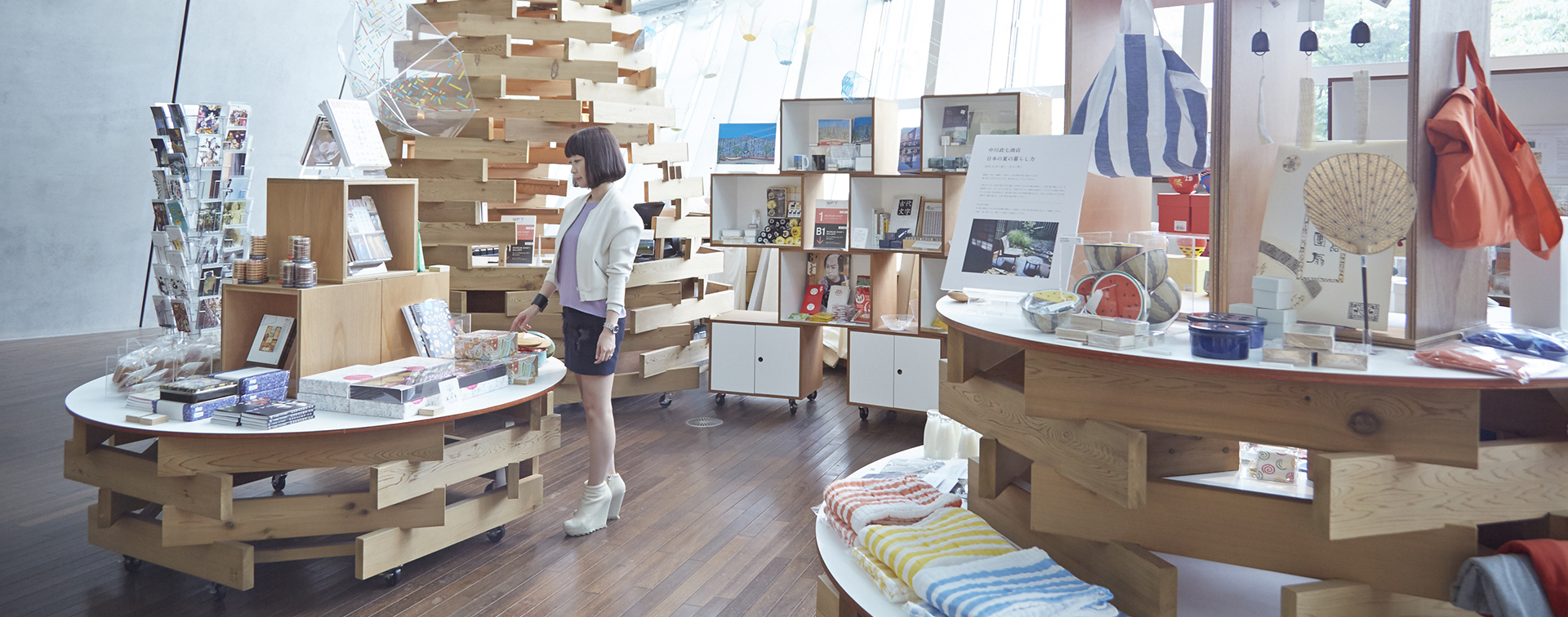
Similar thoughts held by people in their forties
When doing work related to family fashion, I try to show that there are all kinds of families and that it's okay to be unconventional. And when designing instructional materials for small children, I try to introduce unexpected factors and make things that will please not only the children but also the grownups playing with them.
It's the lovely and delightful things that bring enjoyment and make people feel positive. Whether it's an advertisement or an artwork, I want to make things that are fun and will cheer people up in their everyday lives. Of course, that's not an easy thing to do, but that's what I've decided I want to spend my time doing.
Recently my child had to be hospitalized, and I realized that when things are going well, I get the desire to do all kinds of things, but not everything in life can go smoothly. And having become more acutely aware me of that, I've come to hope more strongly than ever that the things I create will have the effect of cheering someone up. People in their forties are probably all interested in lifestyles and how they should live their lives. I suppose we all have similar thoughts. (laughs)
Things that inspire people do not change
I'm often asked what the future of advertising would be like, but it would be boring if we knew, don't you think? It would also probably be uninteresting if we knew the future of Roppongi.
We now live in an age of blogs and SNS, and ordinary people are communicating information. A form of media that we can't even imagine at the moment will probably emerge. People will probably be encountering advertisements in different ways and in different places, and advertising will be increasingly customized to the individual. But even if the ways they encounter the advertisements change, the things that inspire people will stay the same - they have hardly ever changed.
That's why it's important to think about human beings and universal themes. What interests me most are the people I see around me. So I don't think give much thought to the future, and I don't make things to fit any envisaged image of the future.
Instead of pondering about the future, I prefer to expand the things that interest me right now. After all, it is what you do now that leads to the future.

Souvenir from Tokyo
A souvenir shop and art gallery at the National Art Center, Tokyo. The souvenir shop sells a variety of innovative items that express the contemporary spirit of Tokyo; the items include manga books, art books, handcraft and artwork by young designers.
Editor's thoughts
The interview time was short, and Eguchi-san said she hoped we didn't mind her "talking so fast." The things she talked about were very interesting and the members of the editorial department who are all in our forties kept nodding in agreement. The photo shoot for this article took place at Souvenir from Tokyo which sells Eguchi-san's picture book "Pan no osama (bread king)".
(edit_kentaro inoue)



















